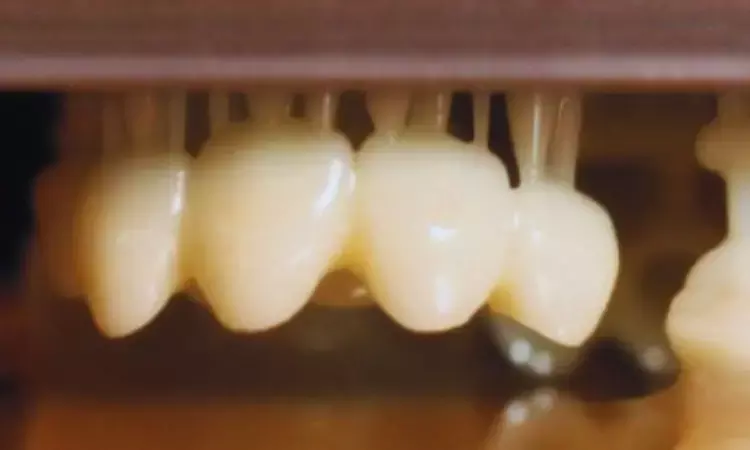- Home
- Medical news & Guidelines
- Anesthesiology
- Cardiology and CTVS
- Critical Care
- Dentistry
- Dermatology
- Diabetes and Endocrinology
- ENT
- Gastroenterology
- Medicine
- Nephrology
- Neurology
- Obstretics-Gynaecology
- Oncology
- Ophthalmology
- Orthopaedics
- Pediatrics-Neonatology
- Psychiatry
- Pulmonology
- Radiology
- Surgery
- Urology
- Laboratory Medicine
- Diet
- Nursing
- Paramedical
- Physiotherapy
- Health news
- Fact Check
- Bone Health Fact Check
- Brain Health Fact Check
- Cancer Related Fact Check
- Child Care Fact Check
- Dental and oral health fact check
- Diabetes and metabolic health fact check
- Diet and Nutrition Fact Check
- Eye and ENT Care Fact Check
- Fitness fact check
- Gut health fact check
- Heart health fact check
- Kidney health fact check
- Medical education fact check
- Men's health fact check
- Respiratory fact check
- Skin and hair care fact check
- Vaccine and Immunization fact check
- Women's health fact check
- AYUSH
- State News
- Andaman and Nicobar Islands
- Andhra Pradesh
- Arunachal Pradesh
- Assam
- Bihar
- Chandigarh
- Chattisgarh
- Dadra and Nagar Haveli
- Daman and Diu
- Delhi
- Goa
- Gujarat
- Haryana
- Himachal Pradesh
- Jammu & Kashmir
- Jharkhand
- Karnataka
- Kerala
- Ladakh
- Lakshadweep
- Madhya Pradesh
- Maharashtra
- Manipur
- Meghalaya
- Mizoram
- Nagaland
- Odisha
- Puducherry
- Punjab
- Rajasthan
- Sikkim
- Tamil Nadu
- Telangana
- Tripura
- Uttar Pradesh
- Uttrakhand
- West Bengal
- Medical Education
- Industry
Honeycomb Surface Design Enhances Bond Strength of 3D-Printed Zirconia, Study Finds

China: A recent study published in the Journal of Prosthetic Dentistry has highlighted a promising advancement in dental materials, demonstrating that modifying zirconia surfaces with honeycomb-like structures significantly boosts their bond strength. The research explored the potential of 3D printing technology to create surface patterns that improve the adhesion of zirconia to other dental materials—a key concern in prosthetic and restorative dentistry.
In dental applications, one of the key limitations to the widespread clinical use of zirconia is its poor bonding affinity to resin materials. While surface microstructures have been shown to enhance bonding performance, the impact of specifically designed honeycomb patterns remains insufficiently understood. To address this, Xiaoqiang Liu, Department of Prosthodontics Peking University School and Hospital of Stomatology, Beijing, PR CHINA, and colleagues aimed to investigate how honeycomb surface modifications influence the bond strength to zirconia fabricated using advanced customized jetting (ACJ), a cutting-edge 3D printing technology.
For this purpose, the researchers designed honeycomb-patterned zirconia surfaces with varying depths (60, 80, and 100 µm) and widths (100, 200, and 300 µm) to assess their effect on bond strength. Control samples were polished and sandblasted. Each group was divided based on the application of 10-methacryloxydecyl dihydrogen phosphate (MDP). Surface roughness was evaluated using an optical profiler, and resin cylinders were bonded using resin cement. Shear bond strength (SBS) was tested mechanically, and fracture patterns were examined under a stereomicroscope. Statistical analyses included the Shapiro-Wilk, Levene, three-way ANOVA, and Kruskal-Wallis tests to determine significant differences across groups.
The study led to the following findings:
- The honeycomb design with 100 µm depth and 300 µm width demonstrated the highest surface roughness (Sa) of 15.34 µm.
- Specimens treated with 10-methacryloxydecyl dihydrogen phosphate (MDP) exhibited significantly greater shear bond strength (SBS) than those without MDP.
- In groups without MDP, the control showed an SBS of 7.11 ± 2.4 MPa, while the 100 µm depth and 300 µm width honeycomb group achieved the highest SBS at 11.38 ± 2.0 MPa—an increase of 60.6%.
- Among MDP-treated groups, SBS values were significantly higher in specimens with 100 µm depth and widths of 200 µm (14.73 ± 2.6 MPa) and 300 µm (16.39 ± 3.0 MPa) compared to controls (12.50 ± 2.3 MPa).
- The group with 100 µm depth and 300 µm width under MDP treatment showed a 31.1% improvement in SBS over controls.
- Adhesive and mixed failures were more common in non-MDP groups, while cohesive and mixed failures predominated in MDP-treated samples.
The study demonstrates that integrating honeycomb surface structures on zirconia, particularly when combined with 10-methacryloxydecyl dihydrogen phosphate treatment, can significantly enhance shear bond strength.
"Both the depth and width of these microstructures play a critical role in determining bond performance, highlighting the importance of optimized surface design in improving the bonding efficacy of 3D-printed zirconia in dental applications," the authors wrote.
Reference:
Cao, X., Lyu, J., Li, Y., Zhou, Y., Tan, J., & Liu, X. (2025). Effects of honeycomb surfaces on bond strength to zirconia fabricated with 3-dimensional printing. The Journal of Prosthetic Dentistry. https://doi.org/10.1016/j.prosdent.2025.03.023
Dr Kamal Kant Kohli-MBBS, DTCD- a chest specialist with more than 30 years of practice and a flair for writing clinical articles, Dr Kamal Kant Kohli joined Medical Dialogues as a Chief Editor of Medical News. Besides writing articles, as an editor, he proofreads and verifies all the medical content published on Medical Dialogues including those coming from journals, studies,medical conferences,guidelines etc. Email: drkohli@medicaldialogues.in. Contact no. 011-43720751


